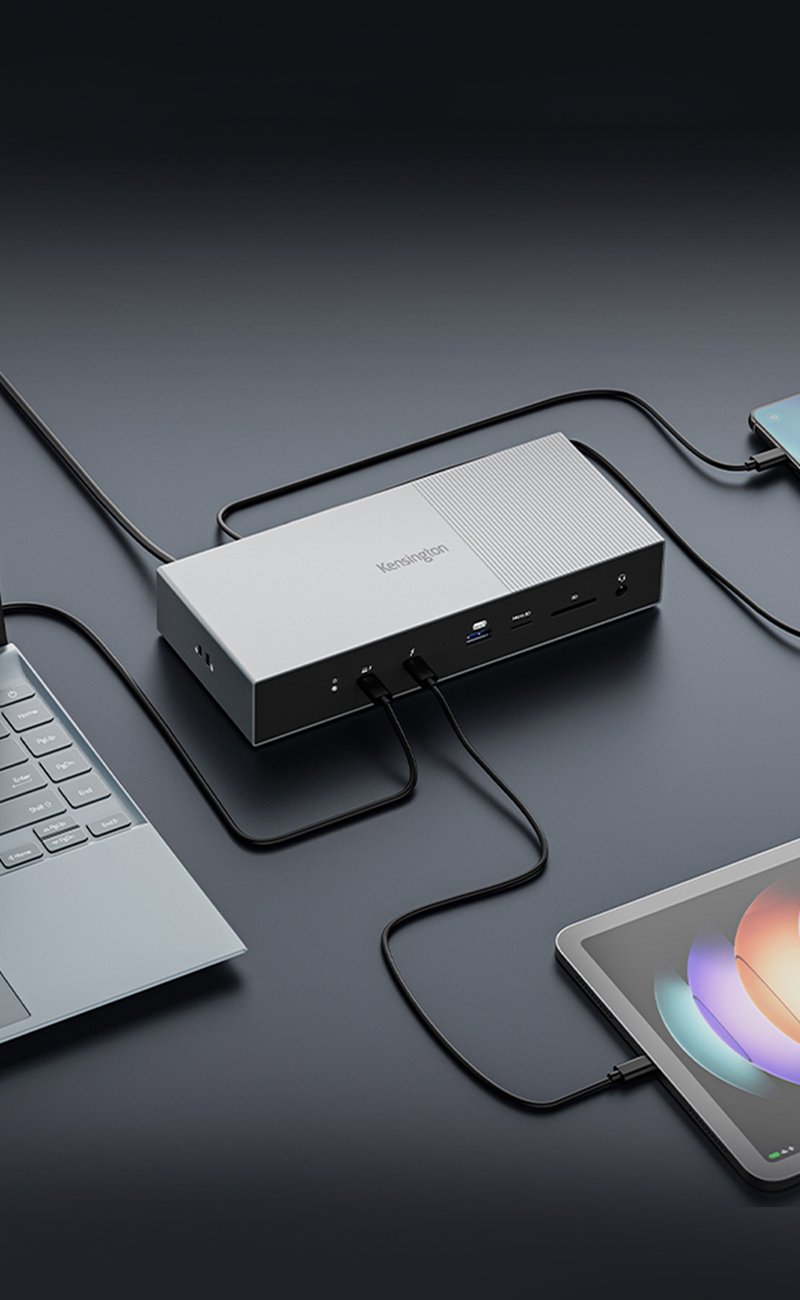Premium Professional Bundle
Thunderbolt™ 5 Docking Station
Seamless multi-monitor setups, 80Gbps transfers, 120Gbps bandwidth boost, and 140W power delivery.
Shop Now

Seamless multi-monitor setups, 80Gbps transfers, 120Gbps bandwidth boost, and 140W power delivery.
Shop Now
Free Shipping on Orders $49+
Power your desk setup with Kensington’s USB-C® hubs, docking stations, and DisplayPort™ video adapters. Whether you need a laptop docking station for expanded connectivity, a USB hub to manage multiple accessories, or a video adapter for high-resolution external displays, Kensington has the right solution.
Explore our FAQs to learn more about different types docking stations and USB Hubs.
Premium Professional Bundle
SD4790P EQ USB-C® and USB-A 10Gbps Quad 4K Hybrid Dock - 100W PD - DP & HDMI - Windows/macOS/Chrome
SD4845P USB-C 10Gbps Triple Video Driverless Docking Station with 85W Power Delivery (DFS) - TAA
SD5900T EQ Thunderbolt™ 4 Quad 4K 40Gbps Dock with DisplayLink® Technology – Midnight Blue
Classic 3.5mm Headphone
Classic USB-A Headphone
SD5768T EQ Thunderbolt™ 4 Dual 4K Docking Station with Thunderbolt™ Share
SD5500T and SD5550T Thunderbolt™ 3 and USB-C Dual 4K Hybrid Docking Station - 60W PD – Windows/macOS
SD5700T Thunderbolt™ 4 Dual 4K Docking Station with 90W PD - Windows/macOS/Chrome
MD120U4 USB4 Portable Docking Station – 100W Pass Through Charging – HDMI - TAA
G1000P USB-C Mini Dock Single 4K Video 85W Power Pass-Through - Chrome/Windows/macOS
SD5780T Thunderbolt™ 4 Dual 4K/6K Docking Station with 96W PD - Windows/macOS - TAA
UH7000C USB 3.0 7-Port Hub + Charging
USB-C to Dual HDMI 1.4 Video Adapter
SD4820P USB-C 10Gbps Dual Video Driverless Docking Station - 60W PD - DP++/DP++/HDMI – Windows
SD4700P USB-C & USB-A 5Gbps Dual 2K Hybrid Dock - up to 60W PD-DP & HDMI - Windows/macOS
StudioDock™ iPad Docking Station
DisplayPort 1.2 (M) to HDMI (M) Passive Unidirectional Cable, 6ft
SD1650P USB-C Single 4K Portable Docking Station with 100W Power Pass-Through
UH1450P USB-C® Mobile Dock
Classic USB-C Headset with Mic
VU4000D USB 3.0 to DisplayPort 4K Video Adapter
USB-C 3.2 Gen2 10Gbps Cable with 100W Power Delivery, 1 meter
SD4842P EQ USB-C® 10Gbps Triple Video Driverless Docking Station with 100W Power Delivery – DP/HDMI®
There is no standard definition in the industry. Kensington defines docking stations and USB hubs/mobile docks as follows: While both expand your laptop's connectivity, they serve different purposes based on power requirements, port selection, and display capabilities.
A laptop docking station is designed for desk setups that require multiple ports, stable power, and high-performance display connections. It comes with its own power adapter, providing dedicated power delivery instead of relying on the laptop. Most Kensington docking stations feature:
A USB hub is a smaller, more portable solution for users with basic connectivity needs. If it does not include a power pass-through feature, it's considered a pure USB hub. If it includes a power pass-through feature—allowing you to use a USB-C® power adapter for pass-through charging—it is considered a mobile dock. Unlike standard SD docking stations, USB hubs and MD mobile docks do not come with a separate power adapter.
Key differences:
If you need a portable solution to expand USB ports, support basic video output, and are comfortable setting up power pass-through without a built-in power supply, a USB hub or mobile dock is a great choice. For full desktop setups with multiple monitors, high-speed data, and integrated power delivery, a Kensington SD standard docking station is the ideal solution. To understand the difference in more detail, visit this blog.
A DisplayLink® docking station (also known as a GPU-agnostic docking station) uses software-based compression to transmit video over USB, requiring driver installation. In contrast, a Thunderbolt™ docking station utilizes both PCIe and DisplayPort lanes, enabling plug-and-play data and video transfer without the need for additional software.
If you need a general-use laptop docking station that's widely compatible and supports multiple displays, a DisplayLink® dock is a great choice. However, if you require faster data speeds, zero-compression video output, and daisy-chaining, a Thunderbolt™ docking station is the better option.
Plug-and-play setup -- No drivers required; it uses DisplayPort™ Alt Mode to output video directly to monitors.
Up to 100W power delivery -- Charges your laptop and provides power to many of your connected devices. Typically includes a port for phone charging.
Multi-display support --Supports up to triple 4K displays on Windows and a single 4K display on macOS (due to macOS not supporting Multi-Stream Transport (MST) over USB- C®)
Fast data transfer -- Up to 10Gbps with USB-C® Gen 2 and up to 5Gbps with USB-C® Gen 1.
Cost-effective -- Typically more affordable than Thunderbolt™ docks.
Great for productivity -- Ideal for users with standard connectivity needs using USB-C Windows laptops.
If you have a USB-C® Windows laptop, this type of dock is a well-balanced, high-value solution for both home and office setups. Visit this site to find the USB-C dock that best suits your needs.
Cables used for Thunderbolt™, USB4, and DisplayPort™ video transfer fall into two categories: active cables and passive cables. The main difference lies in how they manage signal transmission over different lengths.
An active cable has a built-in signal booster and/or video conversion ICs, allowing it to maintain full performance over longer distances. Ideal for:
A passive cable does not have a signal booster, making it best for shorter connections:
If you're setting up a multi-monitor desk setup or a Kensington docking station an active cable ensures maximum performance and reliability. For basic connections within close range, a passive cable is a simple and budget-friendly alternative.
Selecting the right docking station, USB hub, or adapter depends on your laptop's ports, external display needs, and data speed requirements. Here's what to consider:
Kensington provides universal docking stations designed for seamless multi-device connectivity across Windows, macOS, and ChromeOS. Kensington docking stations support USB-A, USB-C®, HDMI®, DisplayPort™, Ethernet, and SD card slots, making them adaptable to various desk setups.
Kensington offers a variety of high-performance docking solutions, including:
Visit this page to explore all Kensington connectivity solutions.